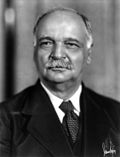This article relies largely or entirely on a single source .(November 2011) |
| 1932 presidential election | |
  Nominees Hoover and Curtis | |
| Convention | |
|---|---|
| Date(s) | June 14–16, 1932 |
| City | Chicago, Illinois |
| Venue | Chicago Stadium |
| Candidates | |
| Presidential nominee | Herbert C. Hoover of California |
| Vice-presidential nominee | Charles Curtis of Kansas |
| Results (president) | Herbert Hoover (CA): 1126.5 (98.5%) John J. Blaine: 13 Calvin Coolidge: 4.5 Joseph Irwin France: 4 James W. Wadsworth: 1 |
The 1932 Republican National Convention was held at Chicago Stadium in Chicago, Illinois, from June 14 to June 16, 1932. It nominated President Herbert Hoover and Vice President Charles Curtis for reelection. [1]
Contents
- Presidential nomination
- Presidential candidates
- Vice Presidential nomination
- Vice Presidential candidates
- See also
- References
- Bibliography
- External links
Hoover was virtually unopposed for the nomination. Despite the economic crisis facing the country, the convention praised Hoover and pledged itself to maintain a balanced budget.














